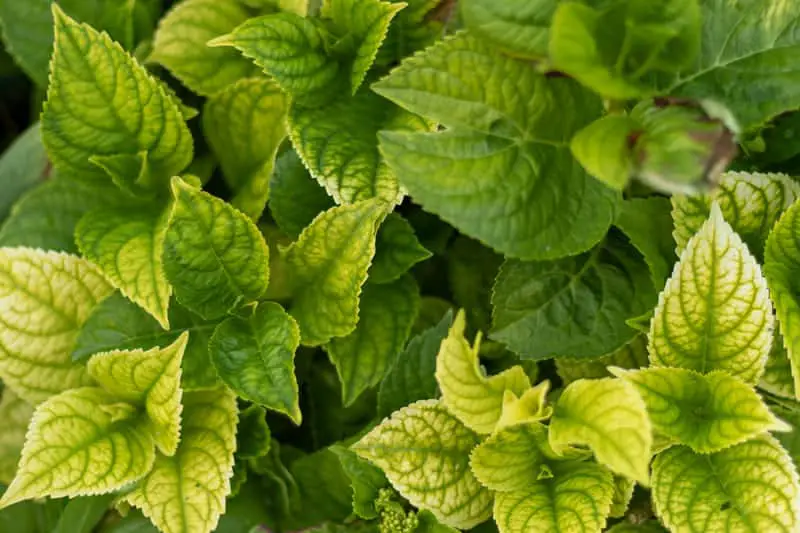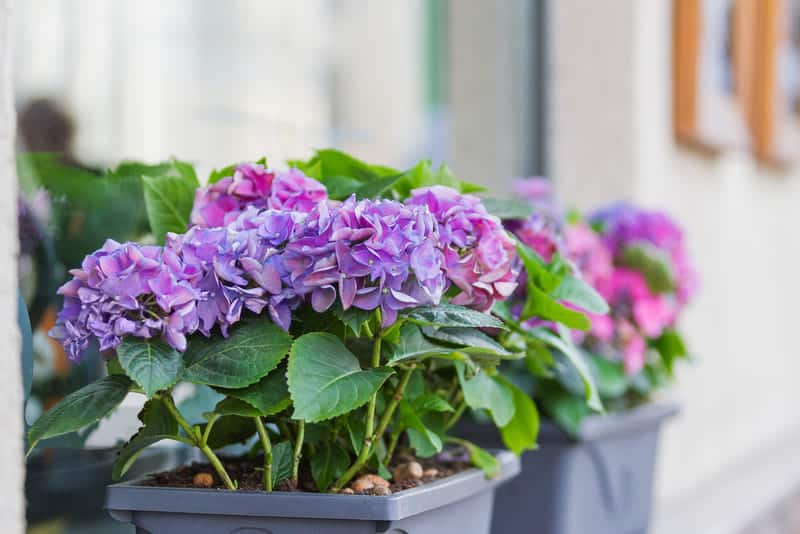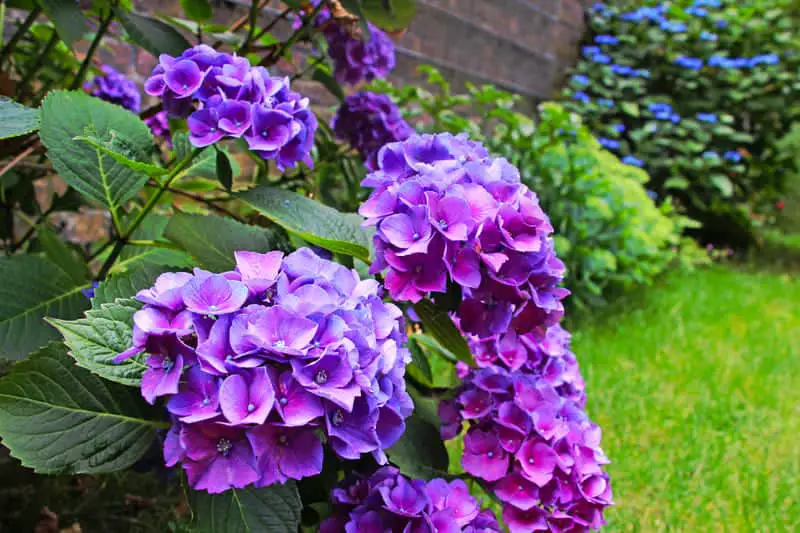With their large, attractive flower heads and stunning varieties of colours available, hydrangea shrubs are popular garden plants. This group contains over 75 unique species, with most being native to Asia and the Americas.
Yellowing leaves are a common issue suffered by all species of hydrangea shrubs. Like most plant ailments, yellow leaves can be due to a variety of problems, causing much frustration among gardeners.
The main reasons for hydrangea leaves turning yellow include:
- Nutrient deficiency
- Over or under watering
- Chlorosis – iron deficiency caused by pH being over 6
- Diseases
- Improper lighting
- Drastic changes in temperature
The most common of these issues is nutrient deficiency due to improper pH or nutrient-depleted soils, and poor watering practices.
If you suspect the yellowing leaves are due to soil issues, you will want to assess the soil and the yellowing pattern of the leaves to determine exactly what nutrients your plant is lacking.
Then, by adding amendments such as compost, manure, or fertilizer, you will be able to help your hydrangea get the nutrients it needs.
Also check: Hydrangeas Wilting
Additionally, you should pay attention to how much and how often you water your plants. Hydrangeas should be watered only when the top few inches of soil are dry, and should be given a thorough soaking each time.
Underwatered hydrangeas are likely to have yellow, wilting, and drooping leaves. Increase the frequency and amount of watering for your shrub to help solve this issue.
Hydrangeas prefer fairly moist (but not soggy) soil, so give the roots a good soaking and allow water to be absorbed into the soil before applying more.
In this article, we will cover more detail on soil nutrients, watering, and other potential causes of yellow leaves in hydrangea plants.
By doing a little troubleshooting and looking carefully at your current plant care, you can narrow down the cause of yellow leaves on your plant.
How do you fix yellow hydrangea leaves?
The way you fix hydrangea leaves turning yellow depends on the key issue causing the yellow leaves. This can be difficult to determine, but once you do you will be able to adjust your plant care accordingly to take care of the problem.
As mentioned before, a common issue with hydrangeas is nutrient deficiencies. Getting a soil test for your garden might be the best way to test if there are issues with your soil. Iron, nitrogen, and magnesium are some of the key nutrients hydrangeas need.
Test the soil in early spring to get an accurate idea of the levels available in growing season. If nutrient levels are too low, leaves may turn yellow.
To correct low levels of these nutrients, amend the soil with things like organic compost, cheleated iron, manure, or magnesium sulphite.
After testing your soil, if you discover the issue is low levels of iron then you should also have the pH of your soil tested. Low levels of iron in the soil is possibly due to high pH (over 6).
Additions of a soil acidifyier or hydrangea blueing tonic are both possible solutions to high pH/low iron in the soil.
If you suspect you may be over or under watering your hydrangeas, you will want to adjust your watering schedule.
Exact amounts of water needed can vary depending on where you are located, due to differences in humidity and temperature during the peak growing season.
In general, aim for 2-3 deep, thorough waterings every week whenever the top of the soil is dry. Your plant may take some time to adjust to receiving more or less water, so give it a few weeks before changing other aspects of its care.
More: Types of Hydrangeas
Hydrangea Diseases
Diseases are another potential cause of yellowing leaves. Other than removing the diseased plant material, it can be tricky to treat these issues. Instead, aim to prevent common diseases by following the guidelines below.
| Disease | Treatment/prevention |
| Root rot | Avoid overwatering hydrangeas and keeping soil overly soggy |
| Hydrangea mosaic virus | Clean pruning tools before and after use |
| Tomato ringspot virus | Control nematode populations via insecticide |
Some other potential causes of yellowing leaves include improper lighting or changes in temperature. To protect your hydrangea shrub during seasonally unusual temperatures, cover them with breathable fabric to keep them warm on cold nights, or shade them from unusually hot summer days.
For improper light levels, you may have to consider relocating your shrub to another area of your yard. Hydrangea light requirements can vary greatly for the many unique varieties and species.
In addition, these shrubs likely need more direct sunlight in northern regions and partially sunny in southern areas. Carefully consider your location and the type of hydrangea you have when choosing a spot in your yard.
Overall, providing the proper conditions for your hydrangeas across all aspects of plant care (light, water, temperature, nutrients) will help to prevent issues such as yellowing leaves and make your plants more resistant to other issues like pests and disease.
What does an overwatered hydrangea look like?
Hydrangea shrubs are often planted outside in the ground, and even though this makes them less likely to be overwatered than if they were potted, it is still possible! Some signs of overwatering in hydrangea bushes are:
- Yellow leaves
- Drooping and prematurely falling leaves
- Fewer buds on stems
- Misshapen flower clusters
If a hydrangea is overwatered for long enough, it will develop root rot. Root rot is a fungal disease that thrives in moist environments.
Plants that suffer from root rot will exhibit a lot of the symptoms described aboves. Unless your plant is potted, you aren’t likely going to be easily able to check if the roots are suffering from root rot (appearing soft, mushy, and black in colour).
Instead, assess your watering habits and adjust accordingly if you think the yellow leaves on your plant are due to overwatering.
More: How To Deadhead Hydrangeas
How often should you water your hydrangeas?
All species and varieties of hydrangeas prefer fairly consistent moisture. During the peak growing season, you should water at a rate of about 1 inch per week.
Hydrangeas benefit from frequent, deep waterings so try and water thoroughly about 3 times a week in the summer. Depending on your location, watering can be scaled back or even stopped in the winter time.
If you are worried about not properly watering your hydrangeas, there are a couple of things you can do. Adding mulch to the base of the plants over the root zone help to regulate the temperature around the shrub and retain water in the soil.
As mulch breaks down and decomposes, it also adds needed nutrients and organic matter to the soil around your hydrangeas, helping them stay healthy.
Alternatively, you can purchase and install simple watering globes. Watering globes hold water in them and slowly release this water into the soil as the ground becomes dry.
Simply fill the globe with water, stick the spout into the soil within the root zone near the base of the plant, and leave it in place until all the water is gone.
This is an easy and fairly cheap solution to underwatering or forgetting to water your plants. Watering globes are also available in different sizes to allow you to leave them in place for longer periods of time.
Newly planted hydrangea leaves turning yellow
If your newly planted hydrangea shrub has leaves turning yellow it is possibly suffering from transplant shock. Transplant shock is a fairly common occurrence experienced by many different plants.
It happens when the plant that is being transplanted struggles to adjust to the new conditions due to the loss of too many roots during removal from the original site.
If it is too severe, some plants will never recover from transplant shock and will continue to decline until they die. Minimize transplant shock by including as many roots as possible when digging up your plant to move it.
Be sure to provide more water than usual in the weeks following planting to help your plant recover and grow new roots.
In some cases, such as transplants occurring in the summer, providing shade to your plant temporarily can help it retain moisture and avoid it being additionally stressed due to high temperatures.
Hydrangea leaves turning yellow and brown
Yellow leaves on a hydrangea that are also turning brown, dry, and crispy, this is likely due to underwatering. Plants that lack water will allow leaves to dry up and fall off in order to preserve water and energy to keep the rest of the plant alive.
Other causes might include fungal disease, which often causes brown and yellow spotting across the leaf surface. Finally, leaves that are brown and dry primarily on the edges and tips of leaves is potentially due to a poor reaction to an applied fertilizer.
To correct underwatering issues, adjust watering to more deep and frequent waterings. For fungal issues, try an identify and treat for disease.
To avoid spreading fungal diseases, be sure to thouroughly clean and disinfect any pruning tools before and after use. Finally, you can try to flush the roots with water to remove excess fertlizer.




